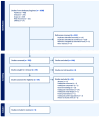Emergency Airway Management: A Systematic Review on the Effectiveness of Cognitive Aids in Improving Outcomes and Provider Performance
- PMID: 39851796
- PMCID: PMC11764273
- DOI: 10.3390/clinpract15010013
Emergency Airway Management: A Systematic Review on the Effectiveness of Cognitive Aids in Improving Outcomes and Provider Performance
Abstract
Background/Objectives: Emergency airway management is a critical skill for healthcare professionals, particularly in life-threatening situations like "cannot intubate, cannot oxygenate" (CICO) scenarios. Errors and delays in airway management can lead to adverse outcomes, including hypoxia and death. Cognitive aids, such as checklists and algorithms, have been proposed as tools to improve decision-making, procedural competency, and non-technical skills in these high-stakes environments. This systematic review aims to evaluate the effectiveness of cognitive aids in enhancing emergency airway management skills among health professionals and trainees. Methods: A systematic search of MEDLINE, Embase, CINAHL, Cochrane Library, Scopus, Web of Science, and ClinicalTrials.gov was conducted from February to March 2024. Studies examining the use of cognitive aids, such as the Vortex method, the ASA difficult airway algorithm, and visual airway aids, in emergency airway scenarios were included. Outcomes assessed included decision-making speed, procedural success rates, and non-technical skills. Data were extracted using standardized protocols, and the quality of included studies was appraised. Results: Five studies met inclusion criteria, encompassing randomized controlled trials, controlled studies, and mixed-methods research. Cognitive aids improved decision-making times (reduced by 44.6 s), increased procedural success rates, and enhanced non-technical skills such as teamwork and crisis management. Participants reported reduced anxiety and improved confidence levels (self-efficacy scores increased by 1.9 points). The Vortex method and visual cognitive aids demonstrated particular effectiveness in simulated scenarios. Conclusions: Cognitive aids significantly enhance emergency airway management skills, improving performance, reducing errors, and increasing provider confidence. Integrating cognitive aids into training programs has the potential to improve patient safety and outcomes. Further research is needed to validate these findings in clinical settings and optimize cognitive aid design and implementation.
Keywords: airway; cognitive aid; decision support tools; emergency; surgical airway.
Conflict of interest statement
The authors declare no conflicts of interest.
Figures
References
-
- Cook T., Woodall N., Frerk C.o., Project F.N.A. Major complications of airway management in the UK: Results of the Fourth National Audit Project of the Royal College of Anaesthetists and the Difficult Airway Society. Part 1: Anaesthesia. Br. J. Anaesth. 2011;106:617–631. doi: 10.1093/bja/aer058. - DOI - PubMed
Publication types
LinkOut - more resources
Full Text Sources
Miscellaneous



